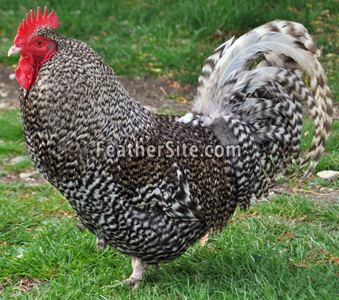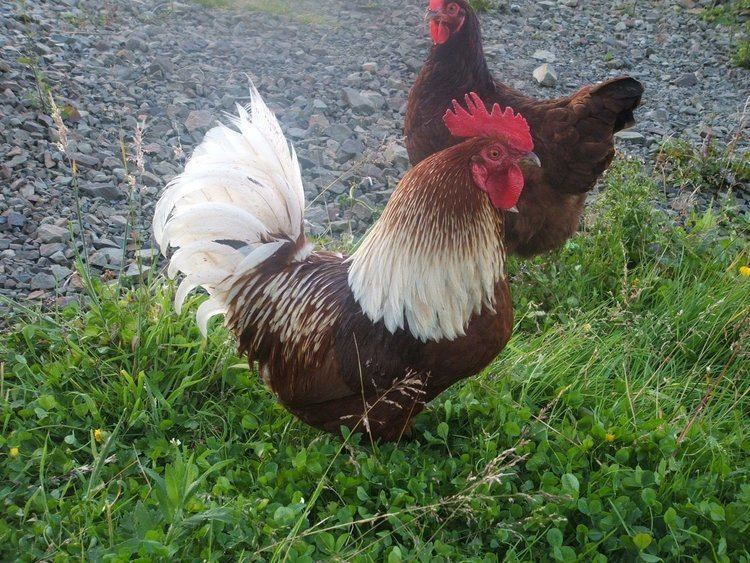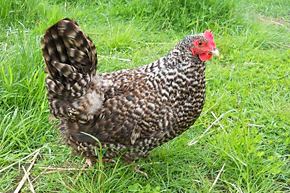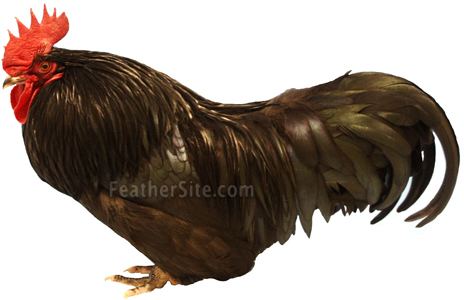Conservation status at risk PCGB Soft Feather: Light Egg production (annual) 180 Egg color Off-white, Tinted | Country of origin United Kingdom Primary use dual-purpose meat/eggs Temperament Quiet Origin United Kingdom | |
 | ||
Recognized variety Brown, Cuckoo, Gold, Silver, Black, White Similar | ||
Schottische kr per scots dumpy national poultry show telford
The Scots Dumpy is a breed of chicken from Scotland. The moniker dumpy, meaning short and stout, refers to the breed's thick-set appearance and extremely short legs. Through history they have been known under a host of names such as: Bakies, Stumpies, Dadlies, Hoodies, or Creepies. They are classed as an endangered breed by the Rare Breeds Survival Trust.
Contents
- Schottische kr per scots dumpy national poultry show telford
- Scots dumpy chicks
- Characteristics
- Origin
- Creeper Fowl
- References

Scots dumpy chicks
Characteristics

The shortness of its legs is its most defining characteristic, and imparts a waddling gait to the chicken; adult birds are less than 5 cm (2 in) off the ground. The birds are longer in the back and have a lower set tail than most breeds.

There is no set colour for the Scots Dumpy, but cuckoo, black, and white are the most common colours. Other patterns/colours occur as sports, or are bred into the phenotype by fanciers. The breed's standard allows for any pattern/colour that is allowed for game fowl to be acceptable, however colour is only worth 10% of the breeds score in competition.

They are a docile breed on the whole, but as with any breed of poultry occasional males can be aggressive. Hens are good layers of light off white to tinted coloured eggs, and are said to make a good meat bird.
Origin

The standardisation of the breed emerged from landraces in the 19th century, though its vernacular history is much older than that. Short-legged birds have been written about in the U.K. for hundreds of years, and there is an archaeological record going back to York in the 11th century.
In addition to this there are several unverifiable legends regarding Scots Dumpies. One of which relates to their use as ambush alarms by the Celts and Picts, and the claim that it was the bird’s superior hearing that enabled them to hear attackers responses to stepping on thistles, which in turn led to thistles being adopted as a Scottish emblem. Other tales tell of them being trained to crow by the hour, day or night.
Scotch Dumpies were first shown in London in 1852. It has been one of the rarest British breeds since the late 1800s. Other references to short-legged birds can go back to Columella where he states he does not approve of dwarf fowls. However, a common reference date of 1678 (as found in the British Poultry Standards) is almost certainly erroneous as this refers to Grigs in John Ray's The ornithology of Francis Willughby. These Grigs were bantam rather than dwarf fowl.
Originally the Scots Dumpy would have been Crofters/Cotters fowl, and its trait of having extremely short legs would have had benefit in naturally restricting the birds free-ranging around the homestead. Other benefits conveyed by this are the ease of catching, and given that the birds exercise less, the flesh on older birds is less well toned and thus more succulent and tender. As Crofters/Cotters fowl they would have a threefold role; to provide eggs, meat, and eat any spillage which would otherwise attract vermin. Their success in foraging for spillage and other food sources to a sufficient level to deliver both eggs and meat would be intrinsic to their success in their niche.
Creeper Fowl
The Scots Dumpy is regarded as being related to other European Creeper Fowl, such as the German Krüper, the French Courtes-Pattes, and the Danish Luttehøns (see Danish hen). It differs significantly from these in having a heavier bone structure, and red earlobes (even though it lays a white to tinted egg). However, references to earlobe colour in the mid 19th century relate Scots Dumpys having full white earlobes.
The short-legged nature of Creeper Fowl is determined by a single (heterozygous) dominant instance of the creeper Cp allele, which has a dwarfing effect on the legs and wings. Unfortunately, two instances (homozygous) of this dominant allele are lethal. Therefore, a short legged creeper fowl will have one instance of the Cp allele and a matching non-dwarfing recessive cp allele.
When breeding this gives rise to a differential outcome. Where two short legged creepers are bred together the arithmetic of the allele combination will result in 50% Cpcp (short legged creepers), 25% cpcp (normal legged creepers) and 25% CpCp (which have the self-terminating lethal combination). The nature of the lethality is that the chicks die in the shell prior to hatching. To avoid a predetermined 25% dead in the shell occurrence a long legged bird can be crossed with a short legged bird. This will give rise to a 50% split in short legged and normal legged offspring.
The dwarf nature of the legs does not appear to have any actual disadvantages to the birds in their native context, and flocks have been known to survive with natural selection situations where normal supposition would presume that the long legged offspring would have more advantages for survival.
